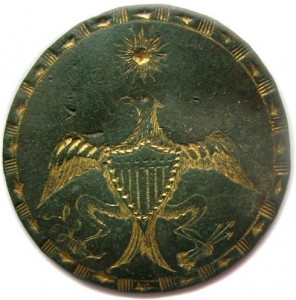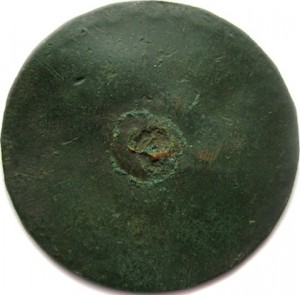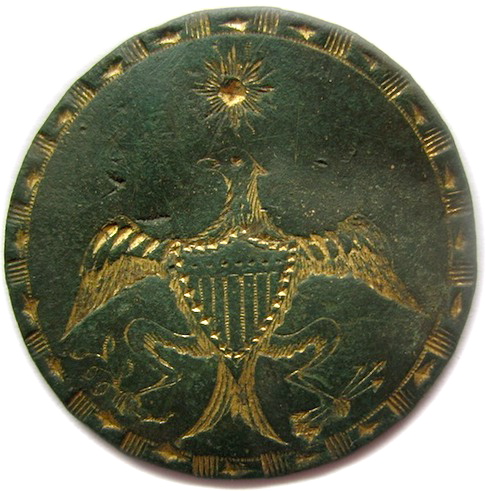I am happy to introduce this Lost George Washington Inaugural Button, and Proudly name this find:
The Federal Eagle With A Heralding Star W/ A
Diamond & Sun Ray Legend
GWI 24-A The Federal Eagle With A Heralding Star W/A Diamond & Sun Ray Legend:
The button is struck on a brass planchet with a gilt finish, measuring approximately 34.74 mm in diameter. It is classified as R-7 in rarity, indicating extreme scarcity. This example is of one-piece construction with a soldered loop shank affixed to the reverse for attachment.
The obverse design features a heraldic representation of the U.S. Federal spread-wing eagle, facing dexter (to the viewer’s left). Positioned above the eagle is an eight-pointed star, commonly interpreted as the Star of Bethlehem, imbuing the device with a Christian religious symbolism that underscores the nation’s self-identification as being under divine providence. The eagle motif itself is derived from the Great Seal of the United States, adopted in 1782, and was intended to symbolize national authority and federal legitimacy in all matters sanctioned by Congress, including official policy and documentation.
To contemporaneous patriots and colonial Americans, the eagle embodied the majestic strength and vigilance of the emergent republic, prepared to meet the trials of sovereignty. In its sinister talon (viewer’s right), the eagle clasps a bundle of three arrows, a traditional symbol of military preparedness. These three arrows are sometimes interpreted allegorically as representing the tripartite structure of the federal government: the Executive, Legislative, and Judicial branches.
Adorning the eagle’s breast is a spade-shaped escutcheon (shield) bordered by thirty-three diamond-shaped indentations. This element may carry symbolic resonance within the context of Scottish Rite Freemasonry, whose thirty-three degrees are emblematic of ascending knowledge and enlightenment. The prominence of masonic symbolism in the material culture of the revolutionary era reflects the influence of Freemasonry, particularly its transmission through the Scottish and Jacobite traditions, as a philosophical and organizational force in the struggle for American independence.

Rob’s collector’s notes:
One theory on the Estoile’s Deep Impression is that this could have possibly have been fitted for a jewel, such as a small Emerald signifying the colors of Scotland. Some kind of clear adhesive could have possibly been used. Dale doesn’t believe it was cut-in for a Jewel. He believes the deep impression, and cross hatch was just added for a glimmering-bling effect to play off a room’s candle or possibly the sun’s light. Either of these two theory is acceptable in my opinion. I do agree that these elaborate Gilt embellished jewelers cuts were done to give GWI 24-A that extra Special Sparkle in the Sunlight; and also offer the wearer an extravagant fashionable political statement to his wardrobe in attendance of a political function or social grand ball.
*** With this new addition, there will be three known GW buttons that are made to Sparkle in the Light, GWI-7B, GWI-21, and the newest re-discovered member to the GW! button family GWI 24-A! All were hand chased and specially crafted by artisans with special intent.
This is 1 of 2 known George Washington Inaugural Button to be Dug (in England) outside of the United States!


*
GWI 24-A THE FEDERAL EAGLE WITH A HERALDING STAR W/A DIAMOND & SUN RAY LEGEND
Color: An Emerald Green With Gold Pattern Highlights.
Metal: Flat, 1-Piece, Hand Engraved Design, Gilt Brass.
Size: 34.75mm. Inaugural Size.
Rarity: R-7 (1 of 2 Known)
Variety Type: 20 Jewel Shape Legend Indentees, 20 Sets of 5 Etched Lines.
Present Condition: An Excavated Specimen, Strong Planchet Condition, An Exceptional Impression Remains.
Obverse Button Analysis: Along with the customs ordered GWI 25, Isabela’s War Eagle this button is the most important and rarest inaugural button to exist !
Reverse Button Analysis: This is a one-piece button with a soldered on loop shank.
Library Records Has Limited Information GWI 24 A-1:
History: Yes Recorded Sales Price: Yes
Current Button Owner and Location: ~ New York ~
Dug around Hampton in Norfolk County England.
RJ Silverstein’s Isabela Collection.~
The following makers marks found are again, consistant with all the marks found on all of the GW buttons studied. We find Trenchards letter “J” in the eye ball of the bird. Several makers marks “V” are found and one VERY unique aspect is that the birds leg joint bend is made to be a chevron “V” as seen on original surviving US Great Seal, the handful. Where this evidence found on this button is “Exceptionally Valuable” as hard evidence that Scot and his associates where behind the making of all of the Washington buttons and these rare eagle buttons. This button has three, clearly seen letter “A’s” that would represent Samuel Allardice who’s marks are found on the Great Seals. Sometimes his marks are clearly seen as “SA” for his name. Scot’s “S” mark is found on an angle, often Scot’s “S” marks are seen as a near number 8 in design. Based on the surviving proposed Great Seal design that has the Fire Pilar and the Jacobite symbolism. The Letter “S/8” can signify te exiled King, James Francis Edward Stuart VIII. Paintings and other engravings of the king by Scot’s teacher, show these “S/8” symbols in his surviving works.
GWI 24-A THE FEDERAL EAGLE WITH A HERALDING STAR W/A DIAMOND & SUN RAY LEGEND
Color: A Rich Green With Gold Pattern Highlights.
Metal: Flat, 1-Piece, Hand Engraved Design, Gilt Brass.
Size: 35mm. Inaugural Size.
Rarity: R-7 (2 of 2 Known)
Variety Type: 20 Jewel Shape Legend Indentees, 20 Sets of 5 Etched Lines.
Present Condition: A Dug Specimen, A Poor Planchet Condition, A Good Impression Remains.
Obverse Button Analysis:
Reverse Button Analysis: This is a one-piece button with a soldered on loop shank.
Library Records Has Limited Information GWI 24 A-2:
History: Yes Recorded Sales Price: Yes
Current Button Owner and Location: ~ No ~
Dug in Fareham, England.
Owned by Craig Slater until 2016.~
Jacobite Interpretation:
I believe the primary designer of this inaugural button variation was Philadelphia Artisan John Vallance (1770-1823). There was some credible dated evidence presented by Gary gianotti as well as maker marks that this was his craftsmanship by crossmatching other GWI designs by him. He believes the button’s partially completed template steel die was worked on during his long boat trip from America to England. Only the Zoroastrian Phoenix would have appealed to Jacobite sympathizers familiar with this history (Practicing or not). We say partially completed because the button does have the maker marks of Master Artisan Robert Scot and two other Philadelphia Artisans James Trenchard, and Samuel Allardice, but knowing how are artisans worked together the steel die hub could have been worked on, put to the side, and then finished by Vallance on his journey across the Atlantic to England. This button’s design is unique for several reasons. This Scottish design was most likely geared for Jacobite supporters in English social clubs. As of date, it is only known George Washington inaugural button found in England. We know the Jacobite movement was established all through the 1760’s and went right through to the American Revolution. It is still my conclusion that most GWI buttons were made in either Canongate Lodge in Scotland, or Birmingham England as a specialty order for Masonic lodges in the U.S.
This button unlike other GWI buttons displays Scottish Royal Culture throughout it’s design. Usually the Scottish Royal Culture that are incorporated within GWI variations have multiple overlaying allusions which were masked on purpose. This button should be viewed as a triumphant tribute to the Jacobite movement in England. Was this variant made for Englishmen who were in support of the rebels (Jacobites) during the American Revolution. There is a lot of evidence supporting this theory, since newspapers and publications were shared across the Atlantic in major cities.
GWI 24-A is the best George Washington inaugural button ever created that houses so many multi-layered allusions into the Scottish Royal culture’s ancient history. The stipples and stripes should be taken together with the eagle as a whole to represent America will go into the future with it’s own virtue with the Enlightened Ideals started in Scotlands Universities and put forth into the Grand Architects Design. The truth about the 7 horizontal stipples (dots) across the top of the shield represent 2 distinct meanings. One of religion with the mask of the European nations which the original British colonies in America was people’d by ( England, Scotland, Ireland, France, Germany, Canada, and Holland). The 13 vertical stripes in the lower portion of the shield is another mask of allusion with 2 meanings. First, it represents the 13 colonies that have become unified as one (E. Pluribus Unum). Under the mask it would represent to people of the era in England, Scotland, and Ireland the King of England and his 12 Sir Knights of the Most Noble Order of the Garter. Circling around the inner perimeter is an incuse ring of very detailed 3 short lines. Most notably this would give reference to Prince Edward Stuart being the 3rd King of England. Within the 3 short lines is the Scottish Regnal Jewels of Scotland. This is in direct reference and messaging of the Bonnie Prince Charlie taking his rightful place as heir to America. Also, there is a 5 petal laurel. Prince Edward Stuart was Crowned with an open Laurel Wreath in Holyroodhouse in 1745. this also could serve as a symbol of the 5 Petal White Rose he picked during the Hanoverian War and put into his cockade before battle. Prince Edward Stuart was born under the Bethlehem Star on December 31st 1720 which is depicted as the button’s estoile. The coming of the future King from the Charles I and Charles II Resistance and Restitution Serpent Snake of Resistance.



